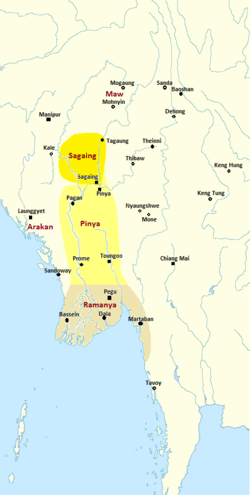Kingdom of Sagaing စစ်ကိုင်း နေပြည်တော် | |||||||||
|---|---|---|---|---|---|---|---|---|---|
| 1315–1365 | |||||||||
 Sagaing Kingdom c. 1350 | |||||||||
| Status | Kingdom | ||||||||
| Capital | Sagaing | ||||||||
| Common languages | Burmese (official) Shan | ||||||||
| Religion | Theravada Buddhism, Ari Buddhism, animism | ||||||||
| Government | Monarchy | ||||||||
• 1315–1327 | Saw Yun | ||||||||
• 1327–1336 | Tarabya I | ||||||||
• 1339–1349 | Kyaswa | ||||||||
• 1352–1364 | Thihapate | ||||||||
| Legislature | None (Rule by decree) | ||||||||
| Historical era | Warring states | ||||||||
| 7 February 1313 | |||||||||
• Sagaing autonomy proclaimed | 15 May 1315 | ||||||||
• Secession from Pinya | 1315–1317 (de facto) 1325 (de jure) | ||||||||
| 1336–1350s | |||||||||
• Maw raids | 1356–1364 | ||||||||
• Maw Sack of Sagaing | April 1364 | ||||||||
| 26 February 1365 | |||||||||
| |||||||||
| Today part of | Myanmar | ||||||||
| History of Myanmar |
|---|
 |
|
|
|
|
|
|
The Sagaing Kingdom (Burmese: စစ်ကိုင်း နေပြည်တော်, [zəɡáɪɰ̃ nèpjìdɔ̀]) was a small kingdom ruled by a junior branch of the Myinsaing dynasty from 1315 to 1365. Originally the northern province of Sagaing of the Pinya Kingdom, it became de facto independent after Prince Saw Yun successfully fought for autonomy from his father King Thihathu in 1315–17. Sagaing formally seceded from Pinya in 1325 after Thihathu's death.
The northern petty state stayed independent for the next four decades mainly due to Pinya's internal divisions. Sagaing itself was full of palace intrigues, and the court led by Nanda Pakyan came to control a string of weak monarchs from the mid-1330s to the 1350s. In the 1350s, Princess Soe Min successfully repaired Sagaing's long-strained relationship with Pinya in order to defend against the northern Shan state of Maw. Sagaing bore the brunt of repeated Maw invasions of Upper Myanmar (Burma) (1356–64). Maw forces broke through in 1364, sacking both capitals of Sagaing and Pinya in succession. In the wake of the latest Maw raid, Saw Yun's grandson Prince Thado Minbya seized both devastated capitals in 1364, and founded the Ava Kingdom in 1365.
Sagaing, like its bigger cousin Pinya, was a microcosm of the fractious small kingdoms period (1287–1555). The small kingdom is remembered in Burmese history as the polity that gave birth to Ava, the dominant power of Upper Myanmar from the 14th to 16th centuries.